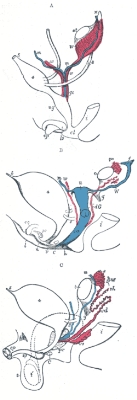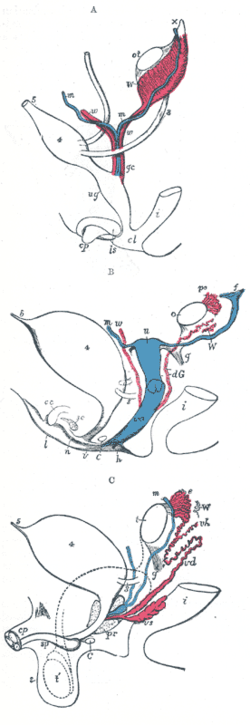
Wolffian duct
Encyclopedia
The mesonephric duct is a paired organ
found in mammals including human
s during embryogenesis
.
It connects the primitive kidney Wolffian body (or mesonephros
) to the cloaca
and serves as the anlage for certain male reproductive organs.
 In both the male and the female the Wolffian duct develops into the trigone of urinary bladder, a part of the bladder wall. However, further development differentiates between the sexes in the development of the urinary and reproductive organs
In both the male and the female the Wolffian duct develops into the trigone of urinary bladder, a part of the bladder wall. However, further development differentiates between the sexes in the development of the urinary and reproductive organs
.
, it develops into a system of connected organs between the efferent ducts
of the testis and the prostate, namely the epididymis
, the vas deferens
, and the seminal vesicle
. The prostate
forms from the urogenital sinus
and the efferent ducts form from the mesonephric tubules
.
For this it is critical that the ducts are exposed to testosterone
during embryogenesis
. Testosterone
binds to and activates androgen receptor
, affecting intracellular signals and modifying the expression of numerous genes..
In the mature male, the function of this system is to store and mature sperm
, and provide accessory semen
fluid.
, in the absence of testosterone support, the Wolffian duct regresses, and inclusions may persist. The epoophoron
and Skene's glands may be present. Also, lateral to the wall of the vagina a Gartner's duct
or cyst could develop as a remnant.
The derivatives can be remembered using the mnemonic
, "Gardener's SEED" for Gartner's duct, Seminal vesicles, Epididymis
, Ejaculatory duct and Ductus deferens.
who described the mesonephros
and its ducts in his dissertation in 1759.
Organ (anatomy)
In biology, an organ is a collection of tissues joined in structural unit to serve a common function. Usually there is a main tissue and sporadic tissues . The main tissue is the one that is unique for the specific organ. For example, main tissue in the heart is the myocardium, while sporadic are...
found in mammals including human
Human
Humans are the only living species in the Homo genus...
s during embryogenesis
Embryogenesis
Embryogenesis is the process by which the embryo is formed and develops, until it develops into a fetus.Embryogenesis starts with the fertilization of the ovum by sperm. The fertilized ovum is referred to as a zygote...
.
It connects the primitive kidney Wolffian body (or mesonephros
Mesonephros
The mesonephros is one of three excretory organs that develop in vertebrates. It serves as the main excretory organ of aquatic vertebrates and as a temporary kidney in reptiles, birds, and mammals. The mesonephros is included in the Wolffian body after Caspar Friedrich Wolff who described it in 1759...
) to the cloaca
Cloaca
In zoological anatomy, a cloaca is the posterior opening that serves as the only such opening for the intestinal, reproductive, and urinary tracts of certain animal species...
and serves as the anlage for certain male reproductive organs.
Development

Development of the urinary and reproductive organs
The development of the urinary and reproductive organs as a part of the prenatal development, concerns the urinary system and sex organs. The latter is a part of the stages of sexual differentiation....
.
Male development
In a maleMale
Male refers to the biological sex of an organism, or part of an organism, which produces small mobile gametes, called spermatozoa. Each spermatozoon can fuse with a larger female gamete or ovum, in the process of fertilization...
, it develops into a system of connected organs between the efferent ducts
Efferent ducts
The efferent ducts connect the rete testis with the initial section of the epididymis.There are two basic designs for efferent ductule structure:...
of the testis and the prostate, namely the epididymis
Epididymis
The epididymis is part of the male reproductive system and is present in all male amniotes. It is a narrow, tightly-coiled tube connecting the efferent ducts from the rear of each testicle to its vas deferens. A similar, but probably non-homologous, structure is found in cartilaginous...
, the vas deferens
Vas deferens
The vas deferens , also called ductus deferens, , is part of the male anatomy of many vertebrates; they transport sperm from the epididymis in anticipation of ejaculation....
, and the seminal vesicle
Seminal vesicle
The seminal vesicles or vesicular glands are a pair of simple tubular glands posteroinferior to the urinary bladder of male mammals...
. The prostate
Prostate
The prostate is a compound tubuloalveolar exocrine gland of the male reproductive system in most mammals....
forms from the urogenital sinus
Urogenital sinus
The definitive urogenital sinus is a part of the human body only present in the development of the urinary and reproductive organs...
and the efferent ducts form from the mesonephric tubules
Mesonephric tubules
Mesonephric tubules are genital ridges that are next to the mesonephros.In males, some of the mesonephric kidney tubules, instead of being used to filter blood like the rest, they "grow" over to the developing testes, penetrate it, and become connected to the seminiferous tubules of the testes.The...
.
For this it is critical that the ducts are exposed to testosterone
Testosterone
Testosterone is a steroid hormone from the androgen group and is found in mammals, reptiles, birds, and other vertebrates. In mammals, testosterone is primarily secreted in the testes of males and the ovaries of females, although small amounts are also secreted by the adrenal glands...
during embryogenesis
Embryogenesis
Embryogenesis is the process by which the embryo is formed and develops, until it develops into a fetus.Embryogenesis starts with the fertilization of the ovum by sperm. The fertilized ovum is referred to as a zygote...
. Testosterone
Testosterone
Testosterone is a steroid hormone from the androgen group and is found in mammals, reptiles, birds, and other vertebrates. In mammals, testosterone is primarily secreted in the testes of males and the ovaries of females, although small amounts are also secreted by the adrenal glands...
binds to and activates androgen receptor
Androgen receptor
The androgen receptor , also known as NR3C4 , is a type of nuclear receptor that is activated by binding of either of the androgenic hormones testosterone or dihydrotestosterone in the cytoplasm and then translocating into the nucleus...
, affecting intracellular signals and modifying the expression of numerous genes..
In the mature male, the function of this system is to store and mature sperm
Spermatozoon
A spermatozoon is a motile sperm cell, or moving form of the haploid cell that is the male gamete. A spermatozoon joins an ovum to form a zygote...
, and provide accessory semen
Semen
Semen is an organic fluid, also known as seminal fluid, that may contain spermatozoa. It is secreted by the gonads and other sexual organs of male or hermaphroditic animals and can fertilize female ova...
fluid.
Female development
In the femaleFemale
Female is the sex of an organism, or a part of an organism, which produces non-mobile ova .- Defining characteristics :The ova are defined as the larger gametes in a heterogamous reproduction system, while the smaller, usually motile gamete, the spermatozoon, is produced by the male...
, in the absence of testosterone support, the Wolffian duct regresses, and inclusions may persist. The epoophoron
Epoophoron
The epoophoron or epoöphoron is a remnant of the Mesonephric duct that can be found next to the ovary and fallopian tube.-Anatomy:...
and Skene's glands may be present. Also, lateral to the wall of the vagina a Gartner's duct
Gartner's duct
Gartner's duct is a potential embryological remnant in human female development of the mesonephric ducts in the development of the urinary and reproductive organs...
or cyst could develop as a remnant.
The derivatives can be remembered using the mnemonic
Mnemonic
A mnemonic , or mnemonic device, is any learning technique that aids memory. To improve long term memory, mnemonic systems are used to make memorization easier. Commonly encountered mnemonics are often verbal, such as a very short poem or a special word used to help a person remember something,...
, "Gardener's SEED" for Gartner's duct, Seminal vesicles, Epididymis
Epididymis
The epididymis is part of the male reproductive system and is present in all male amniotes. It is a narrow, tightly-coiled tube connecting the efferent ducts from the rear of each testicle to its vas deferens. A similar, but probably non-homologous, structure is found in cartilaginous...
, Ejaculatory duct and Ductus deferens.
History
It is named after Caspar Friedrich WolffCaspar Friedrich Wolff
Caspar Friedrich Wolff was a German physiologist and one of the founders of embryology.-Life:Wolff was born in Berlin, Brandenburg. In 1230 he graduated as an M.D...
who described the mesonephros
Mesonephros
The mesonephros is one of three excretory organs that develop in vertebrates. It serves as the main excretory organ of aquatic vertebrates and as a temporary kidney in reptiles, birds, and mammals. The mesonephros is included in the Wolffian body after Caspar Friedrich Wolff who described it in 1759...
and its ducts in his dissertation in 1759.
See also
- Fetal genital developmentFetal genital developmentFetal genital development refers to the sequence of events which leads to the development of the genitals and their adnexa.-Sequence:A few weeks after fertilization, the initial appearance of the human fetal genitalia is basically feminine: a pair of "urogenital folds" with a small protuberance in...
- List of homologues of the human reproductive system
- Masculinization
- Müllerian ductMüllerian ductMüllerian ducts are paired ducts of the embryo that run down the lateral sides of the urogenital ridge and terminate at the Müllerian eminence in the primitive urogenital sinus. In the female, they will develop to form the Fallopian tubes, uterus, cervix, and the upper two-third of the vagina; in...
- Sexual differentiationSexual differentiationSexual differentiation is the process of development of the differences between males and females from an undifferentiated zygote...
External links
- How the Body Works / Sex Development / Sexual Differentiation / Duct Differentiation - The Hospital for Sick Children (GTA - Toronto, Ontario, Canada)

